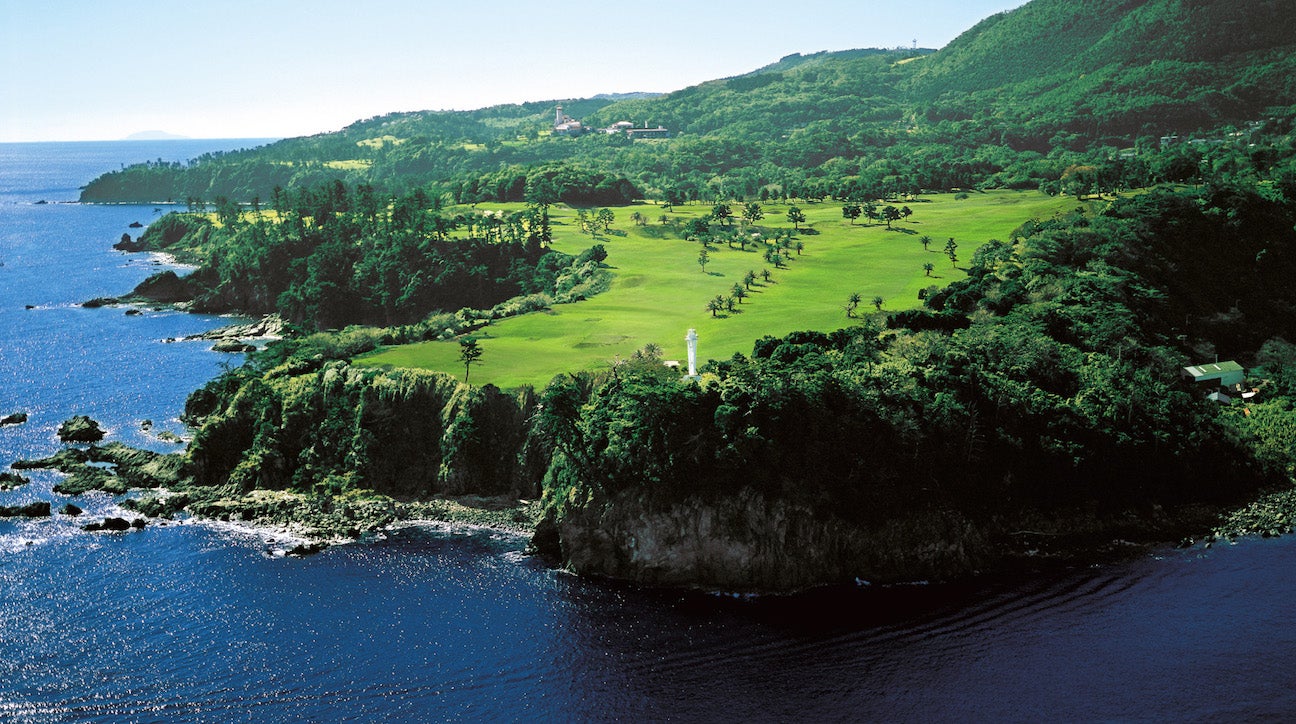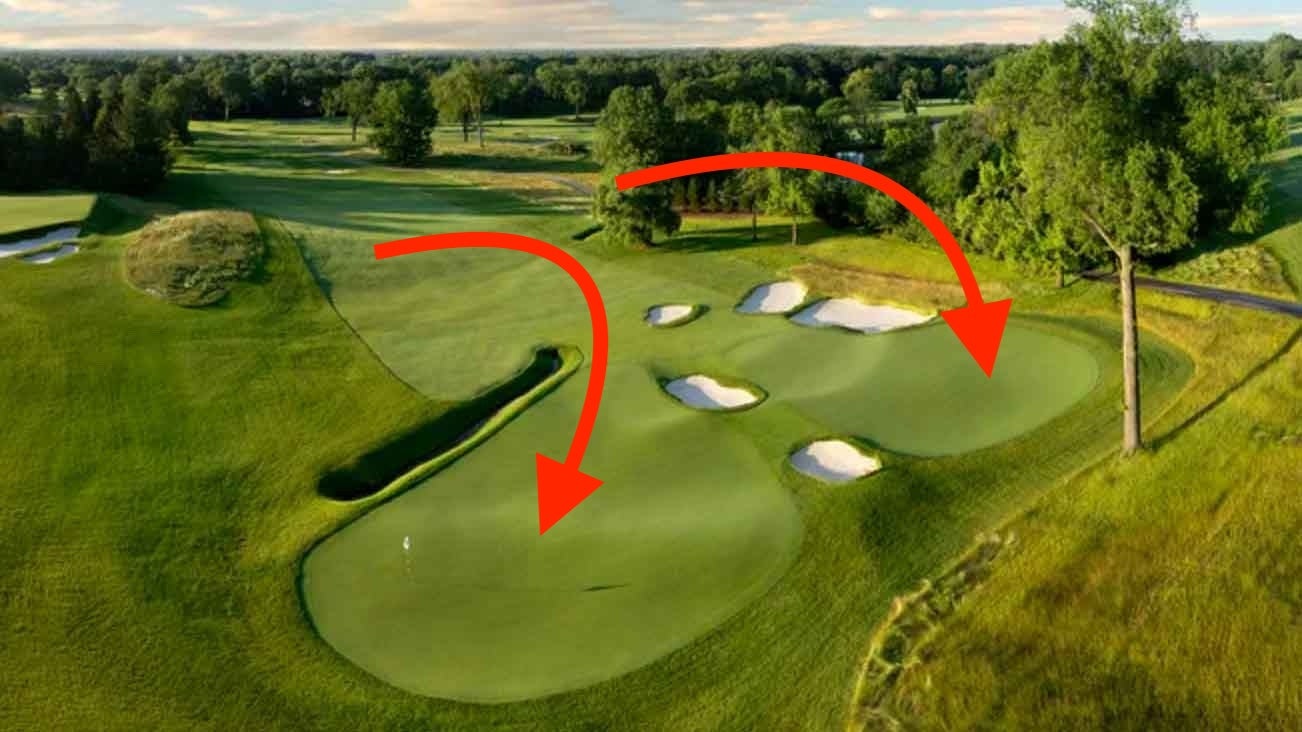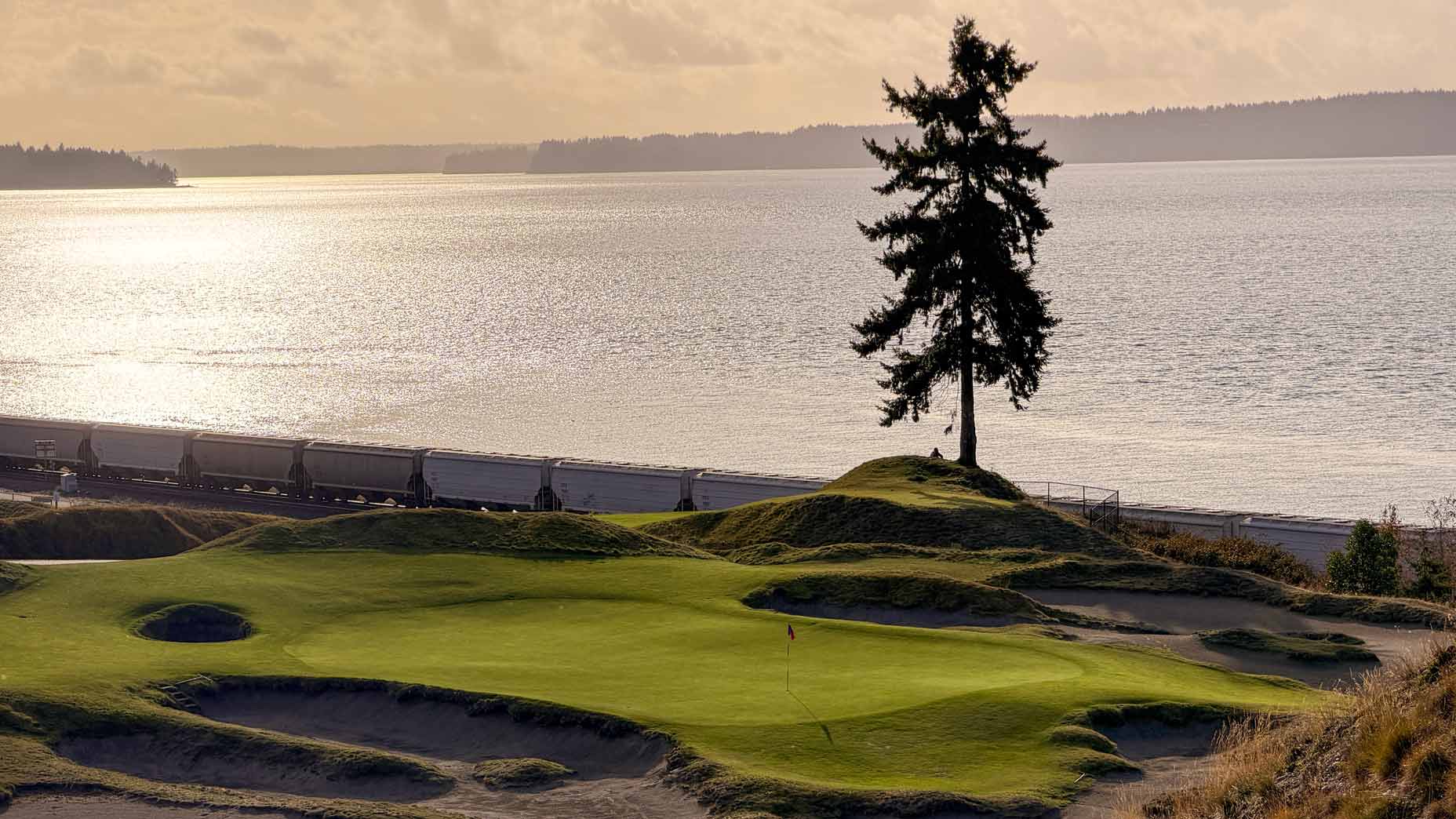The taxi delivered me to Yokohama Country Club early, so I stored my suitcase and had myself a look around. Up a short flight of stairs I found the restaurant with its picture windows looking out onto 36 holes of lovely golf terrain. Down another hallway I came across a series of oversized wooden plaques listing past club champions. Chuckling at the universalities that seem to guide this game of ours (and clubhouse décor) the world over, I wandered back toward the lobby where, halfway up another short flight of stairs, a flash of bronze caught my eye. It was a large picture frame showcasing an embossed metal image — a golfer putting his peg in the ground. And there, spread out directly below, was a meticulously maintained Zen garden. It was here my host found me, ogling the mesa-shaped rocks and freshly raked sand.
“Do the caddies tend to this or do the members take turns?” I asked.
My host chuckled at this and indicated that caddies have enough to do without taking on that responsibility. “Besides,” he said, “the sand is meant to represent ripples of water. No caddies in the water hazards here at Yokohama!”
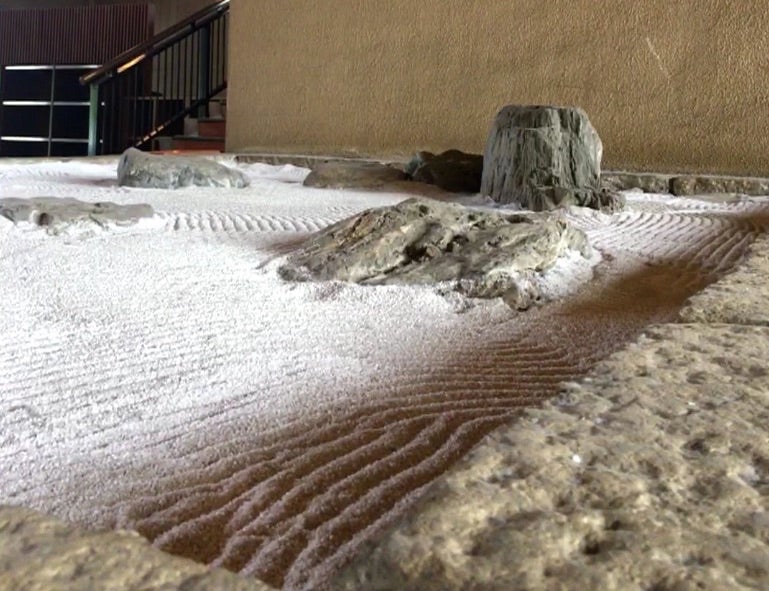
For a solid week in June, I traveled east and south of Tokyo playing a series of Japanese courses, some private, some open to the public. While this was the only Zen garden I encountered in any of the clubhouses, each stop did serve up its own cultural serendipity of equal impact, be it the extraordinary food I was served, the communal post-round baths, the sight of volcanoes fuming in the distance, or courses so well-kept one might well mistake them for gardens. Classical Zen gardens came to prominence during the Muromachi Period (1336-1573) in Japan. They were conceived and still seek to imitate the essence of nature, not its actual appearance — to better aid meditation on the true meaning of life.
In a golfing culture so finely curated as this, the essence is hard to miss.
There are some 2,200 golf courses here, as many as the U.K. and Ireland combined. Hundreds fall into the scrumptious, upscale resort category and, as in the British Isles, most of the private clubs are accessible for a price. While some 1.6 million North American tourists visited Japan in 2017 (according to JTB Tourism Research & Consulting Co., the official, government-appointed stewards of such information), only a tiny fraction appear to have brought their clubs or otherwise played a round during their stays. Such statistics are hard to pin down. Tourism New Zealand, for example, estimates that 2-3% of all incoming tourists play golf during their visits. My friend Bennett Galloway, who’s been living in Japan and working in its golf tourism sector for three decades, believes that only 1 out of every 2,000 North American tourists plays golf while visiting here.
While these are educated guesses ventured in place of hard data, this much is clear: Japan is a huge golf destination. Hundreds of thousands travel here each year for golf holiday-making, mainly from China, South Korea and Taiwan, but also from Europe, Australia and New Zealand. And yet, during my recent visit, I was repeatedly struck by how opaque the Japanese golf culture remains for North Americans like myself. When one considers what a popular tourist destination it already is, how many superb courses exist here, and our established willingness to travel long distances in other directions (to Scotland and New Zealand, for example), one wonders why more American golfers aren’t partaking of Japan’s myriad golfing charms.
As it should, the golf itself remains Japan’s strongest golf-tourism argument. Yokohama CC, for example, was indeed built on superb terrain — in the early 1960s by native architect, Takeo Aiyama. The club’s West Course was recently renovated by Coore/Crenshaw (the East Course was refurbished in 2000).
Most courses here survived into the 21st century with two greens per hole — the traditional Japanese method of maintaining year-round play in a tough agronomic climate, under the duress of heavy traffic. Coore/Crenshaw eliminated these extra greens on the West Course, created 18 comely-but-diabolical replacements, and rebunkered to quite magnificent effect. You will be able to see exactly what I mean this October when YCC hosts the Japan Open.
The day before, I sampled another private club, Abiko CC, just east of Tokyo, which recently underwent a striking renovation of its own courtesy architect Brian Silva and expert shaper Kyle Goalby. Abiko is more historic, built in the 1930s. Shorn of its vestigial greens (and extraneous trees), today more than ever Abiko exudes a generous, prudently forested vibe that New Englanders like myself find pretty irresistible.
Today’s Japanese golf course market — like its counterpart in the U.S. — is significantly overbuilt, the result of a development boom contemporaneous with our own (1990-2005). Most experts predict that, in 20 years’ time, the country will perhaps have only 1,500-1,800 courses. Green fees at private clubs like YCC and Abiko aren’t exactly cheap (pricing is comparable to U.S. resorts) but Japanese resort green fees (and stay/play prices) are coming down because those facilities that will survive the contraction will do so on price.
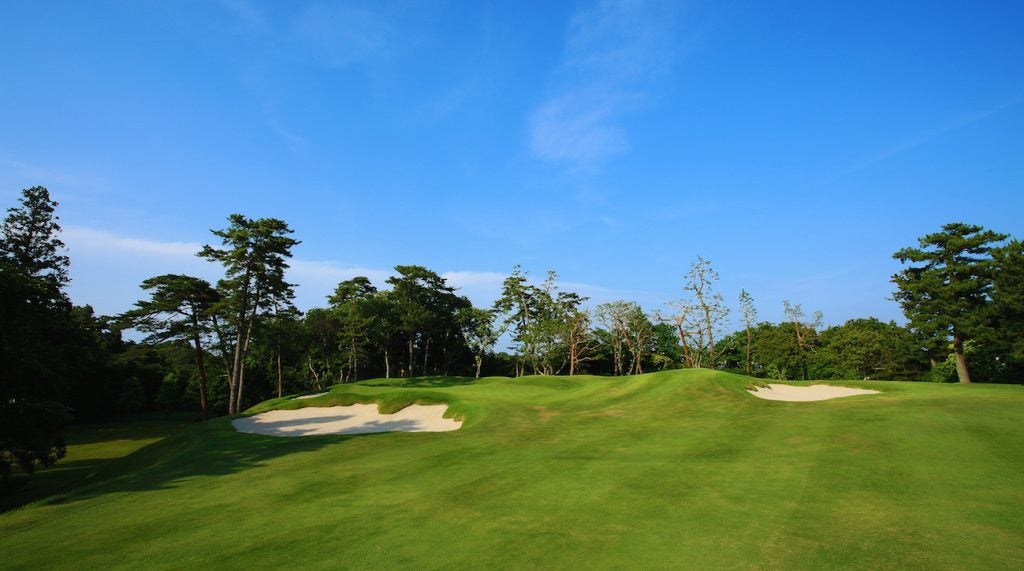
In part because the course stock is shrinking, there is a sort of arms race taking place to renovate, compete and survive. It’s most active at the top. Elite tracks like Tokyo GC, Kasumigaseki, Abiko, Hirono and Yokohama have all renovated recently or remain in the midst of construction. Yes, there are tons of private clubs among the must-plays here, but the same is true of the U.K. Japan’s privates are equally accessible, on the same model, especially today when they need the revenue (!). All this is welcome news for inbound golfers, North American and otherwise. Indeed, the Japanese government just relaxed duty free rules to further entice tourist visitation and spending.
While the first half of my Japanese golfing safari was spent at private clubs, I compensated for this plutocratic element by coming and going entirely by train and taxi: from Narita International Airport to Kashiwa (home to Abiko), from Kashiwa to Yokohama (just south of Tokyo), from Yokohama down the coast to the resort town of Ito.
While the language barrier surely intimidates would-be North American golf holiday-makers a bit, my recent foray thoroughly disabused me (and should disabuse you, reader) of that anxiety. Everywhere I went — train station ticket offices, restaurants (don’t miss Sagami, the teppanyaki restaurant atop the Sheraton Yokohama Bay), certainly hotels and golf clubs, even 7/11s — English was freely and enthusiastically spoken. One could argue that Americans can interact as effectively with locals in Yokohama as they can in, say, Glasgow.
As for the trains themselves, they were as advertised — the model of cleanliness, punctuality and speed. You don’t get a true sense for the latter until you’re standing on a platform and experience a bullet train, known as shinkansen, blowing through at 80 mph. Of course, these are mainly express trains. They slow down quite a bit when passing through a bypassed station.
•••
At Ito Station, a shuttle bus provided the final 15-minute leg to my ultimate destination, 36-hole Kawana, Japan’s most storied resort property. This is resort golf on the grandest of Old World scales, its sprawling art deco hotel replete with elegant dining spaces, wood-paneled sitting rooms, long hallways dotted with historical photographs, and lawns that stretch downhill to the mighty Pacific Ocean.
Down another long hallway is the spa. Whether it’s a resort track or private club, the après golf experience in Japan is as predictable as it is exhilarating. First thing to know: Bring a change of clothes to the course. No Japanese finishes play and rolls directly into the bar or restaurant for drinks. Not hardly. One first goes to the locker room, grabs that change of clothes, strolls down the hall to the spa, luxuriates with his fellow golfers in an oversized marble hot tub, showers, gets dressed, and then hits the bar.
All Japanese courses of any consequence are equipped with separate facilities for men and women. Most are fed by natural hot springs, as the entire archipelago rests atop a roil of volcanic and tectonic activity (many locals have phone apps that track the daily drumbeat of minor earthquakes). At Kawana, however, the communal bath experience stands out for its sublime setting: Nothing like recounting one’s round, buck naked, while reclining in a soothing hot bath, peering down a manicured lawn to the sea.
And what a round to recount. The Fuji Course at Kawana, so named for its views to the northwest, across the Hakone Mountains to Mt. Fuji, is one of the great resort tracks on Earth, No. 68 on GOLF’s World Top 100. Opened in 1936, it was designed by Englishman C.H. Alison, the more globetrotting partner of the inimitable H.S. Colt. Alison also laid out Hirono, the nation’s consensus No. 1 track, on the same trip, but Kawana’s physical qualities put its northern relation to shame. Half a dozen holes play right along the rocky coastline, while the remainder play over dramatic, naturally flamboyant terrain.
The resort’s less heralded track, the sporty Oshima Course (designed by Komyo Ohtani and opened in 1928), shares the same superb ground — every hole serving up long views out to sea. These are but two of 25 different golf properties operated all across Japan by Kawana’s parent company, Prince Hotels & Resorts.
My pal Bennett, a Canadian who’s been living in nearby Shizuoka Prefecture for 30 years, met me for the round at Kawana (locals do not miss the chance to play here). Thoroughly refreshed by our bath, we took our leave and headed north up the coast by car (Ben’s car), then into the Hakone Mountains. This journey was something to behold and little expected — a steep climb followed by a sort of skyline drive atop a winding mountain range that concluded with a circling of the pristine, spring-filled Lake Ashinoko, a former volcanic caldera surrounded by resort towns and national parks.
We arrived after dark at another Prince property, Daihakone Country Club, on the far side of Ashinoko and were delighted to find a killer buffet still operational. Bennett was sure to point out all the locally sourced, seasonal cuisine: tai (fresh red snapper), maguro (tuna sashimi) hamaguri & asari (hard & little neck clams), with zenmai (fern), eukinoto (butter sprout) and asparagus all served in the tempura style.

The subsequent dawn would reveal something further: a beautiful parkland course (expertly maintained by superintendent Tomomi Sakiyama) flanked by still higher peaks to the west and steaming volcanoes to the east.
Graceful and broad, the front nine at Daihakone (“Big Hakone)” zigs and zags over gently rolling ground before venturing across a river into steeper terrain on the back. Here the two-green system remains in place, and it’s a curious thing for a North American to behold. From single landing areas, some holes veer off in two quite different directions, depending on which putting surface is in play. Elsewhere on this 65-year-old layout, both putting surfaces are deployed as part of a single, oversized, dual-green complex, as at the par-4 11th and par-3 17th.
Ten years from now, Daihakone and hundreds more Japanese courses may well be renovated and these vestigial greens removed — such has been the modern refurbishment drill here. That would be both an advance (maintaining 36 greens/approaches for 18 holes is expensive) and a shame, for tradition is surely a vital component of essence.
Bennett has made his home all these years in the Gotemba valley, just over the mountains from Daihakone at the base of Mt. Fuji. He served as director of golf at Gotemba GC for 17 years; today he organizes incoming golf tours all over the country. When climbing the western peaks on our way to Gotemba, I asked if we’d be able to see Mt. Fuji from the other side. He looked at me like the regional naïf I was: Once over the mountains, Fuji-san is literally ubiquitous, dominating the horizon no matter where one might be in Shizuoka Prefecture. At some 12,488 feet, Fuji is enormous, of course. But rarely does one encounter a mountain that rises to such an elevation directly from sea level. Eye-popping.
My last full day in country, I had a choice: Stay the night in Gotemba or take the shinkansan back to Narita and kip at the airport. Ben wisely suggested that we dine locally and I bed down at a local resort. “It’s a bit non-traditional, this place,” he said, showing off his capacity for understatement. Upon checking in at the Blueberry Lodge, part of the Gotemba Kogen Resort, I was escorted through a community of 60 formalized yurts, each whimsically adorned with rural knickknacks and murals plucked from the stories of Peter Rabbit. It was like staying the night in Whoville.
At dusk I wandered down to the communal hot spring/bath house. When I emerged, night had fallen and the whole “village” was warmly aglow, thanks to thousands of white lights spread across the conical rooftops. On the high ground, above Whoville, there loomed a massive collection neon-lit carnival structures and fanciful signage — all of it salvaged from around the world and brought here by the resort’s eccentric owner, or so Bennett explained.
We dined that night at the Gotemba Kogen Brewery (GKB), which sits at the far end of another illuminated flourish, this one more traditional to Japan— a cherry blossom promenade. GKB proved to be a more unexpected serendipity: a proper German beer hall with long communal tables, sausage and schnitzel. Fifteen U.S. dollars provided for unlimited mugs of great variety, all of it crafted on site.
Ten to 20 years ago, we could perhaps forgive North American golfers for looking past such robust, diverse golf destination. There was the perceived language issue and folks who got past that (via more structured, group tours) could not straightforwardly reckon this approach with the American model, i.e., rent a car and tool around at liberty. Well, GPS technology has utterly changed that game, too. Yes, the Japanese drive on the other side, like the Brits. But the signage here is frankly better; rental prices compare favorably. I didn’t rent a car during this trip but should have: I could have gone off schedule and played some of the dozen courses I passed in Ben’s car, or the train. I could’ve taken more flyers on accommodations like the Blueberry Lodge. In short, I could have better explored the essence of this place.

